What is the potential of a pixel as a conceptually and virtually malleable form?. As early as 1966 in Michelangelo Antonioni’s film “Blow Up,” we see the photographer protagonist lose his mind over a cluster of pixels revealing a potential murder. The further he zooms in on/blows up these pixels, the more unclear they become and the less he can put faith in his medium of photography as a form of documentation. In our contemporary cloud of images, we have more faith in their probable manipulation than in their truthful documentation.
Could a pixel actually be used to hide something such as the form of a body? Taking as her inspiration meta tagging and computational photography and well beyond the acceptance of photography’s documentarian failures, artist and writer Hito Steyerl suggests a way around surveillance and permanent cloud footage. In Steyerl’s video “How Not to Be Seen: A Fucking Didactic Educational MOV. File” (2013), she cheekily suggests that short of dropping off the grid we become smaller than the size of a pixel. More realistically, a pixel may be worn by or applied to the subject of an image as a mask or used to distort private information even as it travels at high digital velocity.
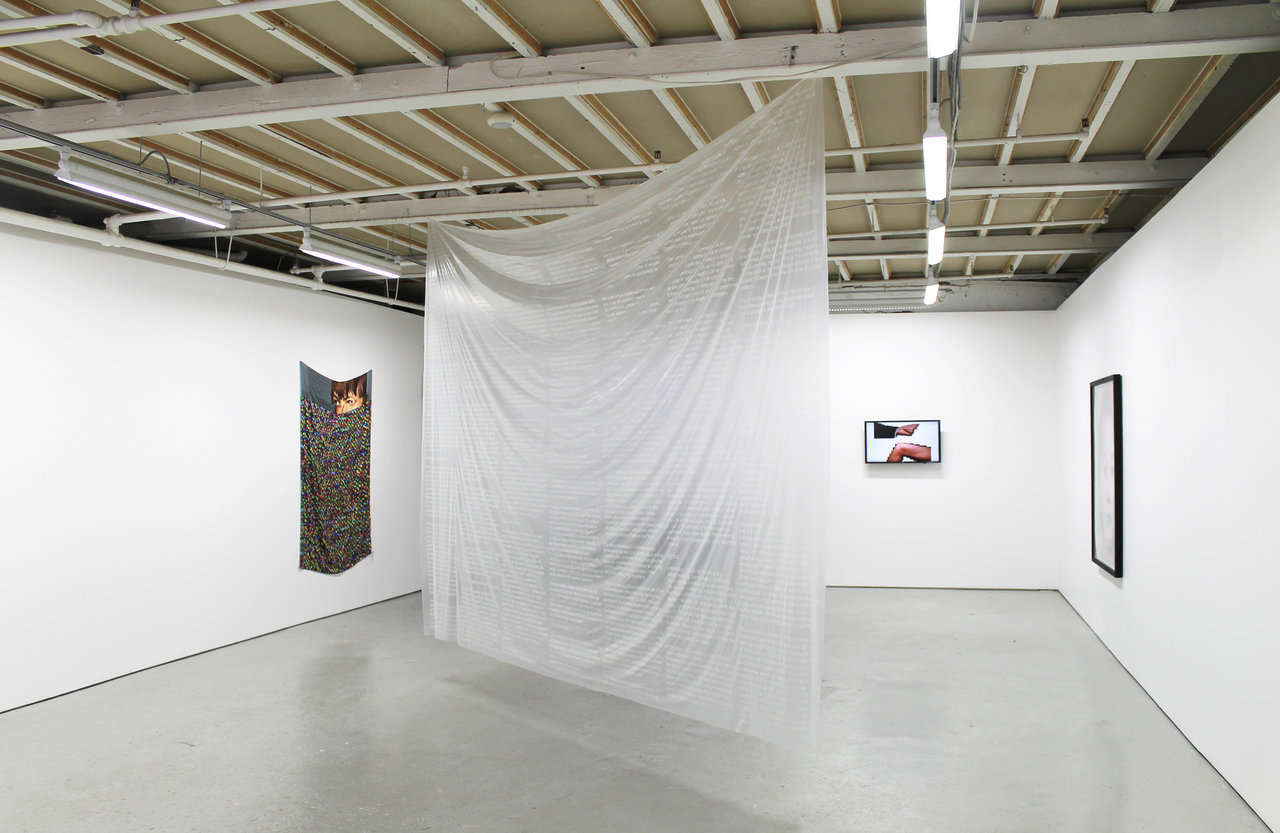 Installation view of TenderPixels.CorruptedFiles , including Terms and Conditions by Fabienne Hess (in the middle). Courtesy of Birch Contemporary
Installation view of TenderPixels.CorruptedFiles , including Terms and Conditions by Fabienne Hess (in the middle). Courtesy of Birch Contemporary
The four artists in the group exhibition TenderPixels.CorruptedFiles at Birch Contemporary adopt the versatile pixel as both a visual and material form to express the fluidity of low-grade mass media content. Louise Noguchi’s four works from the series “Compilation Portraits” (1995) are labour intensive, hand woven, black and white silverprint portraits. Each work contains the pixelated image of a criminal culled from mass media archives or B-rated crime novels, as well as the artist’s mimetic portrait. Her high definition self-portraits (effectively pixelated by the woven pattern) serve to clarify the portraits that were otherwise so distorted, they could hardly be called menacing, and conversely, the clarified guilty portrait obscures the innocence of Noguchi as the subject.
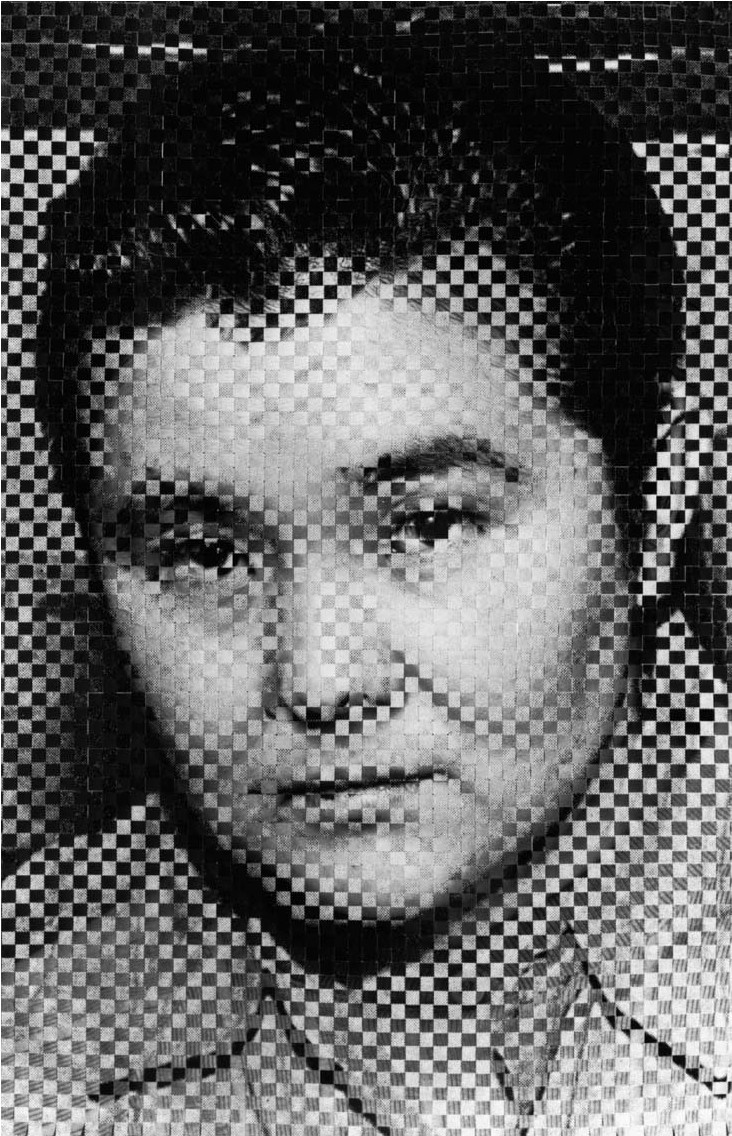 Louise Noguchi, Compilation Portrait #2, 1995, two woven silver prints, 64″ × 43 ¼”. Courtesy of Birch Contemporary
Louise Noguchi, Compilation Portrait #2, 1995, two woven silver prints, 64″ × 43 ¼”. Courtesy of Birch Contemporary
A similar blur between guilty and innocent appears in Fabienne Hess’ work “Terms and Conditions (Email Notices)” (2016), using instead the terms protected and complicit. “Email Notices” includes the ‘fine print’, disclaimers and confidentiality notices that appear at the bottom of corporate/public correspondence. Other works in the series use texts from contracted online agreements, web terms and conditions, and cookie notices. The text is documented in metallic paint on a large translucent dustsheet. Most of the prose is vague and applies not to the protection of the user or their devices; instead it protects the sender and the contract itself. None of this work is pixelated, although the difficulty had in reading the content suggests how the law-full jargon often goes unread. The “Corrupted” series (2013) includes portraits resurrected from supposedly erased archives, half-overwritten with pixelated noise. The rainbow of tiny squares masking all but the foreheads of celebrities are printed on silk as a material metaphor for the slippery cracks through which unwanted images fall.
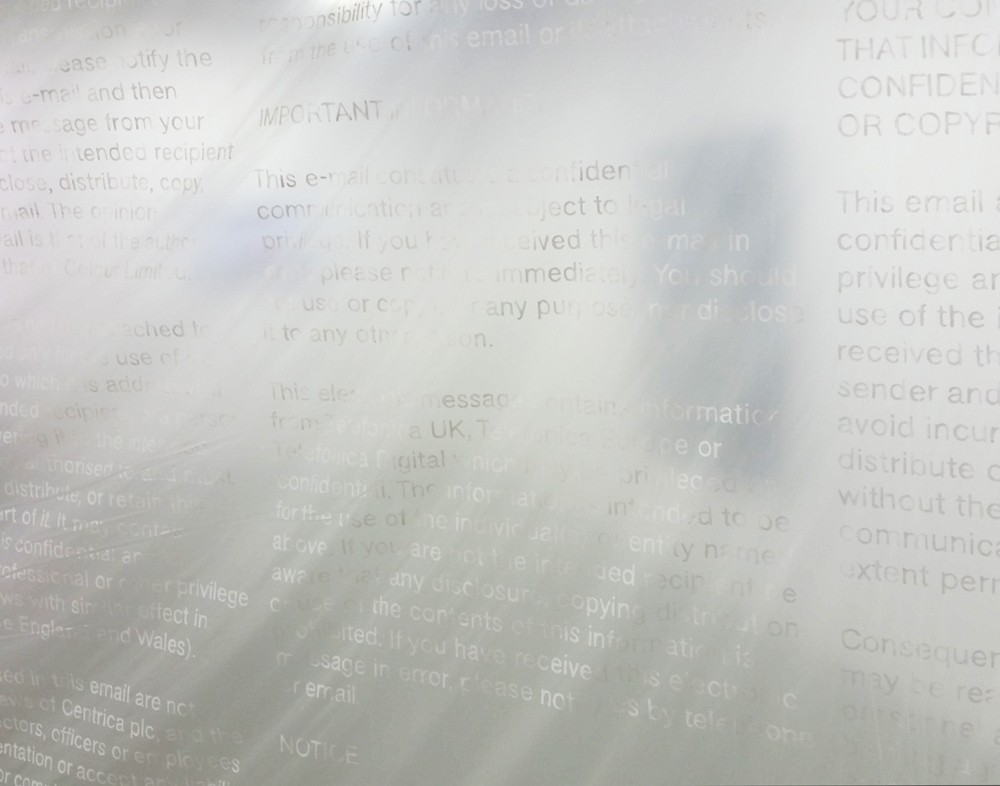 Fabienne Hess, Terms and Conditions (Email Notices), 2016, acrylic on dust sheet (detail), 108″ × 144″. Photo: Alice Pelot
Fabienne Hess, Terms and Conditions (Email Notices), 2016, acrylic on dust sheet (detail), 108″ × 144″. Photo: Alice Pelot
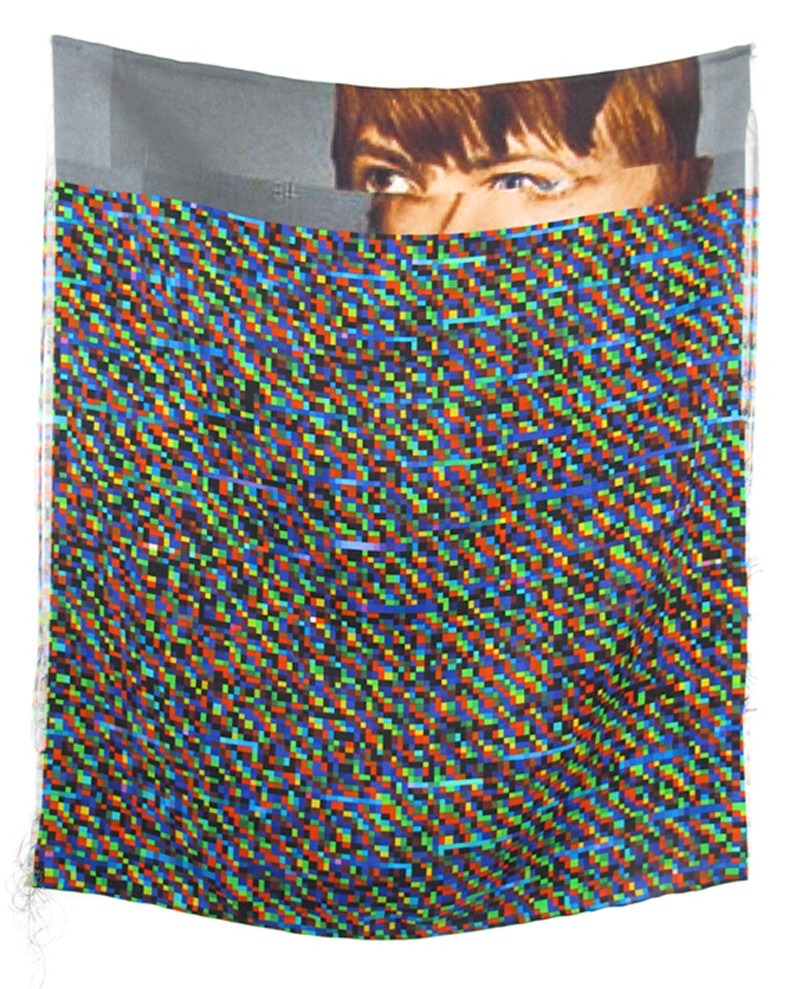 Fabienne Hess, Bowie, 2013, Digital print on silk, 67″ × 49″. Courtesy of Birch Contemporary
Fabienne Hess, Bowie, 2013, Digital print on silk, 67″ × 49″. Courtesy of Birch Contemporary
The works of Hess and Noguchi explore the analogue potential of pixels, while Lorna Mills uses pixels in their natural habitat: low-fi GIF files. GIF files are short loops of static images strung together, used as a tool for expression or communication on social media pages. The images used in “Hand Job” (2014) and “Knee Slapper” (2014) include isolated, heavily pixelated appendages waving back and forth against white backgrounds. Their repetitive animation – hand moving to knee and away from hand – includes subtle allusions to power and gender politics, while the smooth transitions between static images becomes the central aesthetic focus of the medium. Mills’ GIFs are short loops of a length standard to this digital format.
 Lorna Mills, Hand Job, 2014, Animated GIF, edition of 3. Courtesy of Birch Contemporary
Lorna Mills, Hand Job, 2014, Animated GIF, edition of 3. Courtesy of Birch Contemporary
David Hanes’ work “Psycho.gif” (2012-16) on the other hand, is 109 minutes long and composed of over 6000 images. Hanes’ work is not only exploitative of the averagely fleeting GIF sequence; it also exploits our expectations and our attention, playing on Douglas Gordon’s “24 Psycho” (1993). In Hanes’ work (which can be streamed online with an image counter) the low-fi, pixelated format of the fully rendered 1960 Hitchcock horror film lends itself as a metaphor for the blurry truth that carries the plot forward. In addition to the webpage, a USB in the shape of a knife is also for sale containing the entire pixelated GIF file paradoxically in a high-quality version that is too large to be played. Even so, given the choice between paying for a high-quality copy and a free low-quality, over-circulated version, the hunt for the low-fi seems to win out. The USB is more of a conceptual object – the ultimate dematerialization of the image – a high quality, un-viewable copy displayed next to the easily accessible pixelated stream.
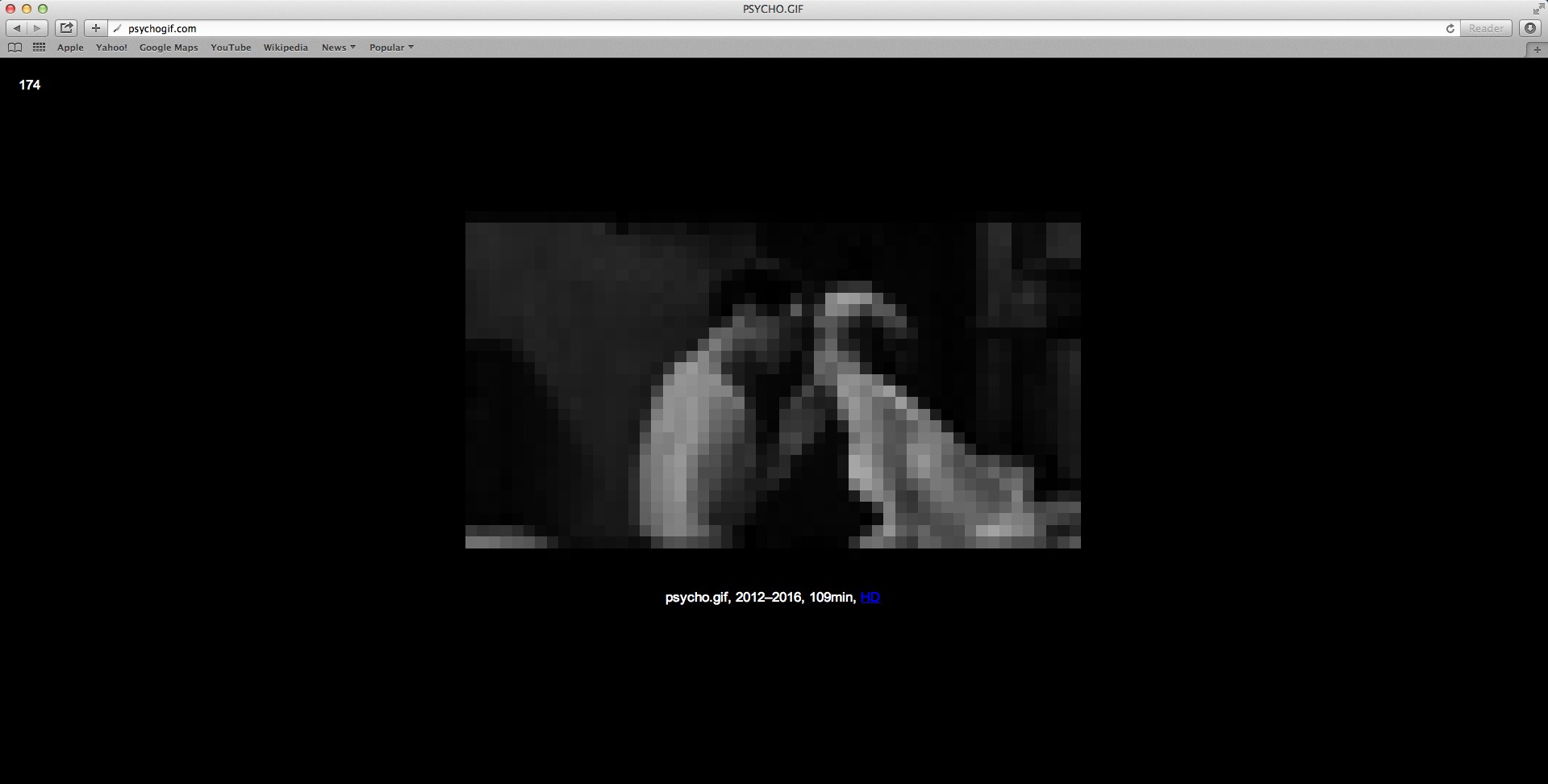 David Hanes, Psycho.gif, 2012-2016, animated GIF, 109 minutes. Unique whole work available on custom USB. Also available one minute segments on custom USB, each unique 1 of 109. Courtesy of Birch Contemporary
David Hanes, Psycho.gif, 2012-2016, animated GIF, 109 minutes. Unique whole work available on custom USB. Also available one minute segments on custom USB, each unique 1 of 109. Courtesy of Birch Contemporary
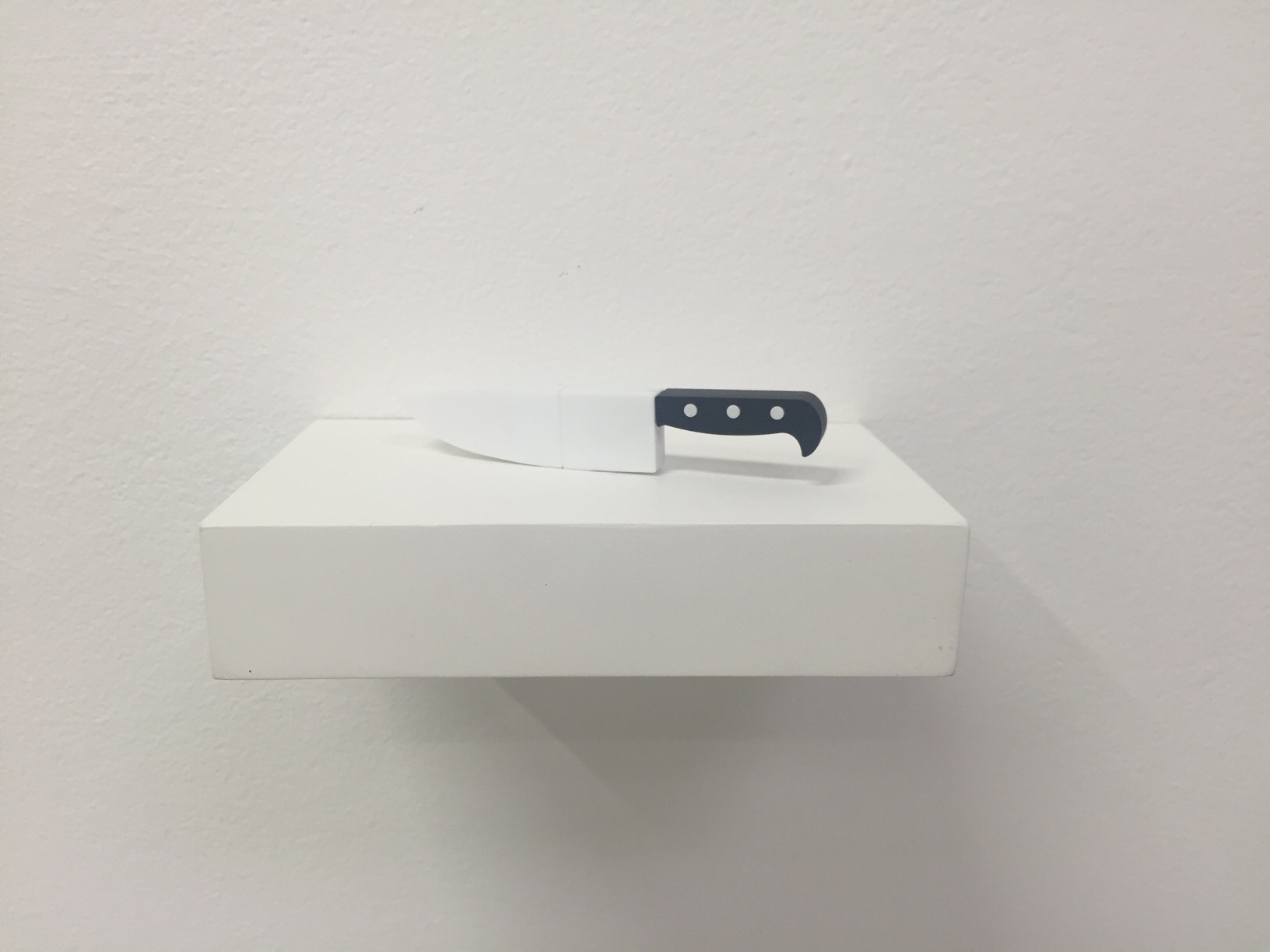 David Hanes, Psycho.gif, 2012-2016, USB. Photo: Alive Pelot
David Hanes, Psycho.gif, 2012-2016, USB. Photo: Alive Pelot
In Hito Steyerl’s essay “In Defense of the Poor Image” (e-flux, issue 10, 2009) she describes one hierarchy of images in relation to their quality. The low-fi image is pixelated, a specter, a thumbnail, a reproduction, often compressed, overwritten and remixed in its circulation. Despite the ‘proletariat’ qualities of these images, it is our own 99% proletariat who consume and circulate them en-masse. The high-tech files remain stored on disks or un-downloadable, unseen, unconsumed and unpopular. In another hierarchy defined by the ‘democratization’ of the image (potential for circulation and viewership), the poor image is desirable. These images contain the rare and forgotten content of our digital rubbish. How can a ‘poor’ or pixelated image continue on its path to dematerialized fame if printed on paper (or silk) and hung in a gallery?
In addition to Hanes’ “Psycho.gif” he has also produced a series titled “Aware” (2013-14) in which gallery documentation and installation shots are Photoshopped and rendered via dye-sublimation printing. The cultural content is void, only a suggestion of white cube is visible. Mostly these prints are a blur. The two works from this series along with the other material works will appear online in the installation shots for TenderPixels.CorruptedFiles in reviews and on Instagram feeds. In their digital format they will already look pixelated, primed for over-circulation, joining again the ranks from which they were copied. Pixels in this exhibition bring to life the familiar habits of prosumers who simultaneously consume and circulate.
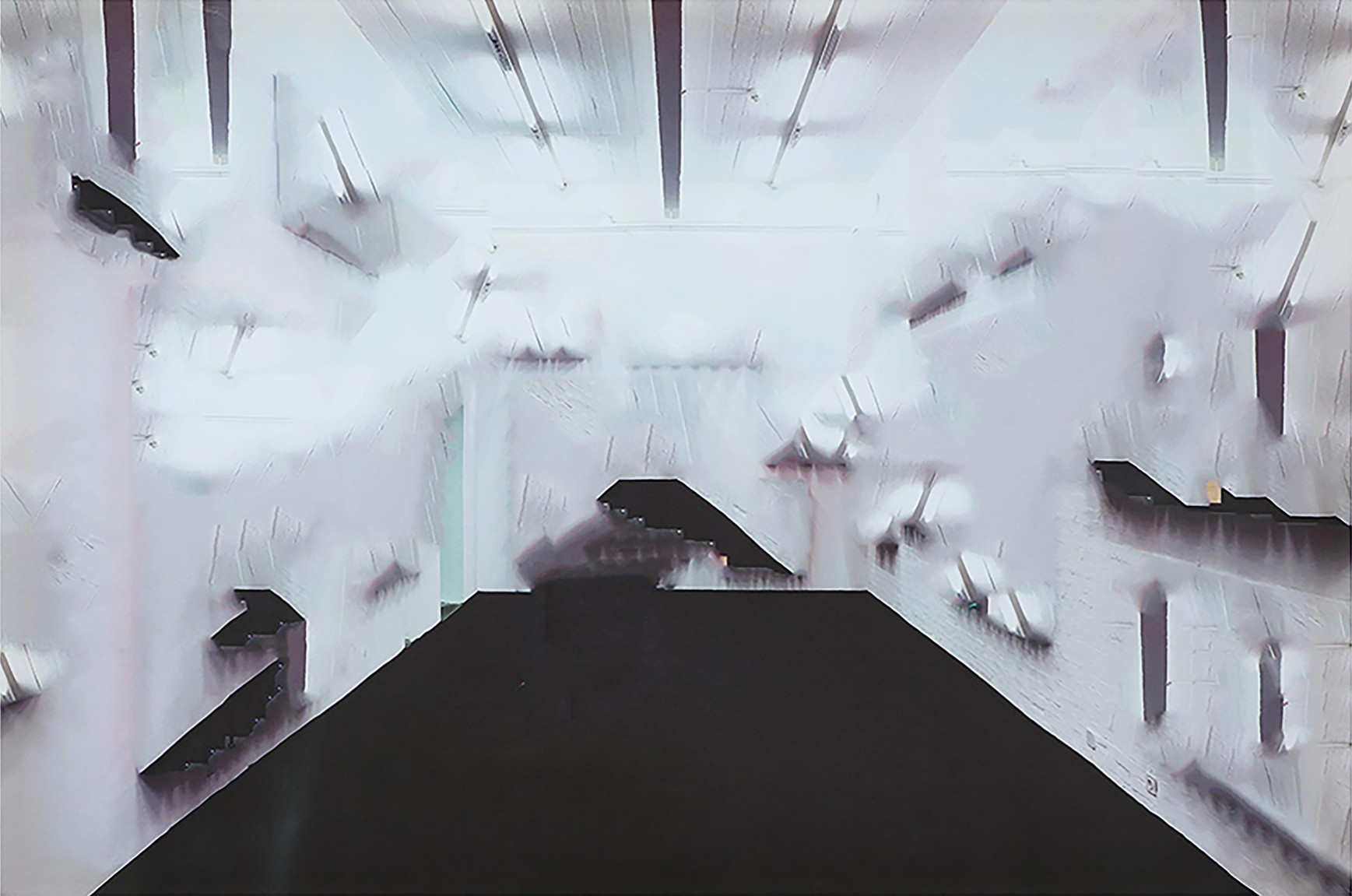 David Hanes, Aware No. 266 (scatter brain), 2013, dye-sublimation print on polyester nylon, wood, 39″ × 59″. Courtesy of Birch Contemporary
David Hanes, Aware No. 266 (scatter brain), 2013, dye-sublimation print on polyester nylon, wood, 39″ × 59″. Courtesy of Birch Contemporary
Alice Pelot
* Exhition information: TenderPixels.CorruptedFiles, a group show featuring works by David Hanes, Fabienne Hess, Lorna Mills, Louise Noguchi, July 21 – August 27, 2016, Birch Contemporary, 129 Tecumseth Street, Toronto. Gallery hours: Wed–Fri 10 am – 6 pm, Sat 11 am – 5 pm.
